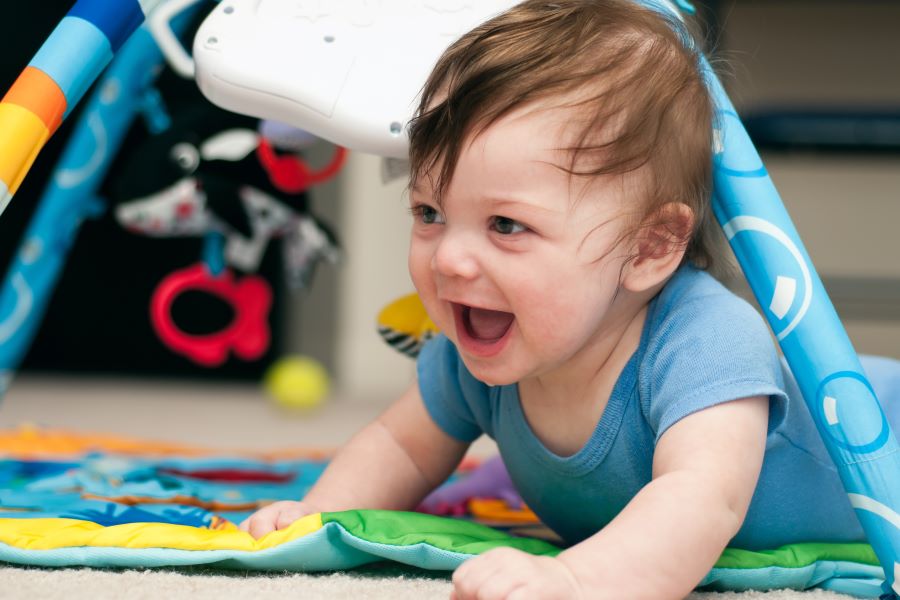Baby Development: Your 6 Month, 3 Week Old

One of the great joys of parenting is teaching your child about emotions — especially love and happiness. While the concept of “teaching” feelings may sound odd, the fact is that babies aren’t born with the tools to understand and identify emotions. It’s also true that your baby’s emotional intelligence doesn’t need to wait until he or she is talking. In fact, at 27 weeks, most babies are:
- Expressing emotional reactions, such as smiling and frowning
- Expressing happiness when they see their parents or caregivers
- Using gestures to communicate or to gain attention
You can help teach your baby to connect feelings with emotions in an easy way: by talking about feelings from the very beginning. You can identify your emotions with statements such as, “I’m frustrated because I spilled my dinner. But I am going to stay calm because once I clean it up, and I can make another plate.” You can also help your baby identify emotions by saying things like, “I can tell you’re happy to see your grandmother because you’re smiling.” At this age, your baby will feel responsible for your emotions, so be careful about expressing negative emotions around your baby.
According to Vanderbilt University, your baby’s “feelings vocabulary” can go beyond happy, sad, and mad. In the weeks to come, try adding other “feelings” words that help convey emotions. These include:
- Cheerful
- Excited
- Friendly
- Joyful
- Overwhelmed
- Safe
- Shy
While you’re teaching your baby about feelings, remember that he or she may not be able to see yours, but they can often sense them. Babies can tell when you’re sad, stressed, or upset. And if your child has a tendency to have strong emotions, there are ways you can help him or her learn discipline during emotionally difficult times.
Discipline and your baby
Parents often don’t like the act of disciplining a child, but at 27 weeks, there is a lot of value in teaching your baby discipline. When your baby is five months old, he or she is already recognizing the difference between “right” and “wrong” activities.
This means that if your baby is trying out a new behavior that you don’t want to encourage in the future, now is the time to start reinforcing that the behavior isn’t acceptable. Here are a few examples:
- Your baby continues to reach for things that are potentially harmful, like a figurine on a table or a picture frame.
- Your baby bites, hits, or bats at you or others when he’s angry or frustrated.
- Your child throws toys (that aren’t meant to be thrown).
Any time your child displays these or other unacceptable behaviors, it’s important to reinforce that they can’t continue. Check in with your baby — are they bored? Tired? Hungry? Check to make sure your house is babyproofed or have a dedicated “yes place” where your baby is free to roam and touch and explore. Your child can learn to refrain from these behaviors, and you can have a well-behaved child as a result. Try this three-part plan to discipline:
- Identify the bad behavior.
- Establish a limit, and give an explanation.
- Provide an alternate option.
For example: you’re holding your child, and you hand over a toy. He throws the toy across the room at an object, purposefully trying to hit it.
For this, you should put your baby down and face him, explaining in a stern voice the behavior that isn’t acceptable. Then, you can offer an alternative, such as, “You can play with this toy instead, but it’s important not to throw things.”
Using this approach, your baby will start to associate the behavior with limit setting, such as a stern voice or being set down and then given an alternative behavior. If you’re consistent and calm, your baby will learn from you how to handle certain situations.
You’ve likely already learned that your baby thrives on routines. An expected bedtime and the bath and cuddles that come before it are all ways to help your baby feel safe and happy. Practicing discipline is another way that you can reinforce positive behaviors. Helping your baby learn boundaries from an early age will pay great dividends in the future.
Bundoo Child Psychologist Eva Roditi gives tips on how to teach your baby about emotions.
Powered by Bundoo®










